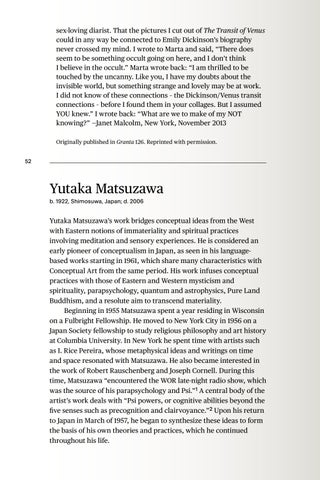sex-loving diarist. That the pictures I cut out of The Transit of Venus could in any way be connected to Emily Dickinson’s biography never crossed my mind. I wrote to Marta and said, “There does seem to be something occult going on here, and I don’t think I believe in the occult.” Marta wrote back: “I am thrilled to be touched by the uncanny. Like you, I have my doubts about the invisible world, but something strange and lovely may be at work. I did not know of these connections – the Dickinson/Venus transit connections – before I found them in your collages. But I assumed YOU knew.” I wrote back: “What are we to make of my NOT knowing?” —Janet Malcolm, New York, November 2013 Originally published in Granta 126. Reprinted with permission. 52
Yutaka Matsuzawa b. 1922, Shimosuwa, Japan; d. 2006
Yutaka Matsuzawa’s work bridges conceptual ideas from the West with Eastern notions of immateriality and spiritual practices involving meditation and sensory experiences. He is considered an early pioneer of conceptualism in Japan, as seen in his languagebased works starting in 1961, which share many characteristics with Conceptual Art from the same period. His work infuses conceptual practices with those of Eastern and Western mysticism and spirituality, parapsychology, quantum and astrophysics, Pure Land Buddhism, and a resolute aim to transcend materiality. Beginning in 1955 Matsuzawa spent a year residing in Wisconsin on a Fulbright Fellowship. He moved to New York City in 1956 on a Japan Society fellowship to study religious philosophy and art history at Columbia University. In New York he spent time with artists such as I. Rice Pereira, whose metaphysical ideas and writings on time and space resonated with Matsuzawa. He also became interested in the work of Robert Rauschenberg and Joseph Cornell. During this time, Matsuzawa “encountered the WOR late-night radio show, which was the source of his parapsychology and Psi.”1 A central body of the artist’s work deals with “Psi powers, or cognitive abilities beyond the five senses such as precognition and clairvoyance.”2 Upon his return to Japan in March of 1957, he began to synthesize these ideas to form the basis of his own theories and practices, which he continued throughout his life.



